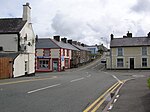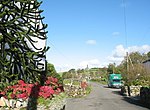Penygroes, Gwynedd
Dyffryn NantlleLlanllyfniVillages in Gwynedd

Penygroes (Welsh pronunciation: [ˌpɛnəˈɡroːɨs] (listen)) is a village in Gwynedd, Wales. The village is located to the south of Caernarfon, and north of Porthmadog, by the A487 road. Penygroes' population stands at 1,793 at the 2011 census, of which 88% are Welsh-speaking, making it one of the most predominantly Welsh-speaking areas of the country. The population of Llanllyfni community, which includes Penygroes and Llanllyfni village, which practically adjoins Penygroes, plus Talysarn, is 4,135 according to the 2011 census.
Excerpt from the Wikipedia article Penygroes, Gwynedd (License: CC BY-SA 3.0, Authors, Images).Penygroes, Gwynedd
Victoria Road,
Geographical coordinates (GPS) Address Nearby Places Show on map
Geographical coordinates (GPS)
| Latitude | Longitude |
|---|---|
| N 53.053 ° | E -4.283 ° |
Address
Heol Buddug / Victoria Road
Victoria Road
LL54 6HD , Llanllyfni
Wales, United Kingdom
Open on Google Maps









